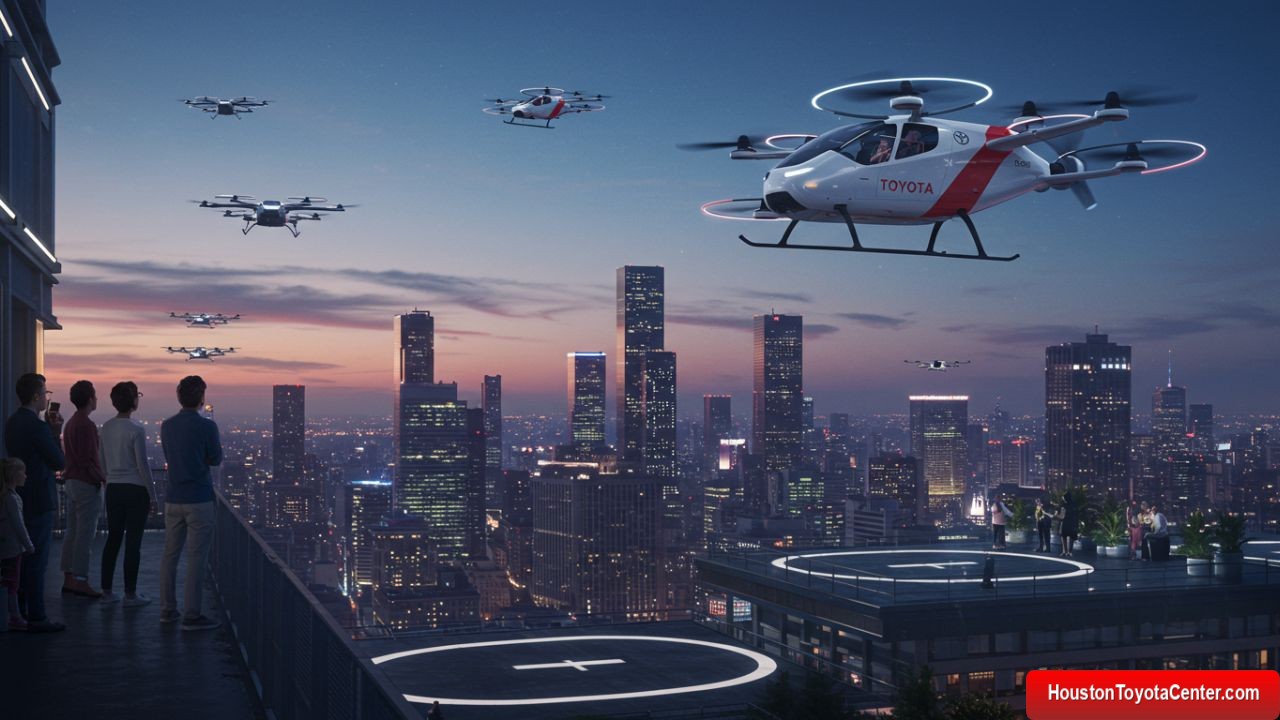The dream of flying cars has hovered in the realm of science fiction for more than a century, from the sketches of Leonardo da Vinci to the airborne traffic in The Jetsons. Now, major automotive and aerospace companies around the world are investing serious capital into making it a reality. One of the most intriguing players in this space is Toyota—a company known for its precision engineering, hybrid leadership, and conservative business strategies. The idea of Toyota backing a flying car project might sound like a marketing gimmick, but it’s anything but that.
In this deep dive, we explore Toyota’s bold leap into the skies: Is this truly the dawn of a new transportation era—or a grounded fantasy with too many technological and regulatory headwinds?
A Brief History of Flying Car Dreams
Flying cars aren’t a new concept. From Henry Ford’s failed “Sky Flivver” in the 1920s to the many prototypes in the Cold War era, inventors have tried—and failed—to bring this vision to life. The problem has never been imagination; it has always been feasibility.
Until recently, flying cars remained impractical due to:
FREE: Quickly identify and understand problems with your vehicle 🚘
CLICK HERE- Heavy engines
- Poor fuel efficiency
- Limited control systems
- Air traffic safety concerns
- Prohibitive costs
But with recent advances in electric propulsion, autonomous navigation, drone technology, and lightweight materials, the dream is inching closer to reality.
Toyota’s Unexpected Entry into the Flying Car Market
Toyota, traditionally not associated with aviation, made headlines when it invested ¥42.5 million (~$375,000 USD) in a small Japanese startup called Cartivator in 2017. By 2020, it ramped up its ambitions dramatically by investing $394 million in Joby Aviation, a California-based company building electric vertical take-off and landing (eVTOL) aircraft.
Why Toyota? Why Now?
Toyota’s move isn’t random. The company is:
- Future-proofing its mobility solutions beyond terrestrial vehicles.
- Responding to competitors like Hyundai, Honda, and Uber’s partnerships in urban air mobility.
- Leveraging its Kaizen-driven engineering culture for aviation-scale precision.
The Cartivator “Skydrive” Project
Cartivator, founded by a group of Toyota engineers and volunteers in 2012, began as a side passion project. Today, under the name SkyDrive Inc., it’s one of the most talked-about startups in Japan’s mobility scene.
SkyDrive SD-03: The First Prototype
In August 2020, SkyDrive conducted a successful manned test flight of its SD-03 prototype. Key features included:
| Feature | Details |
|---|---|
| Aircraft Type | eVTOL |
| Seating Capacity | 1 person |
| Power Source | Electric battery |
| Flight Duration | 5–10 minutes |
| Speed | ~40–50 km/h (25–31 mph) |
| Takeoff/Landing | Vertical |
| Size | Comparable to two parked cars |
While rudimentary, this prototype proved that urban flying vehicles can lift off and land safely, paving the way for commercial development.
The SkyDrive SD-05: Designed for Real Flights
SkyDrive is currently working on the SD-05, a sleek two-seater eVTOL designed for short-range urban flights. This model is expected to:
- Carry two passengers
- Fly up to 10 km (6.2 miles)
- Reach speeds of 100 km/h (62 mph)
- Take off and land vertically
- Be operated autonomously or remotely
It’s being prepared for real-world use during the Osaka World Expo in 2025, with the Japanese government supporting infrastructure and regulatory frameworks for flying taxi demonstrations.
Toyota’s Partnership with Joby Aviation
Perhaps even more exciting is Toyota’s collaboration with Joby Aviation, a U.S.-based eVTOL developer with significant progress on commercial-ready air taxis.
Joby’s Aircraft Specs
| Feature | Details |
|---|---|
| Type | eVTOL |
| Passengers | 4 + 1 pilot |
| Range | 150+ miles |
| Max Speed | 200+ mph |
| Noise Level | <65 dB during flyover |
| Charge Time | ~10 minutes (fast charging) |
Toyota isn’t just investing—it’s actively helping Joby with manufacturing efficiency, safety protocols, and supply chain logistics. Their goal is mass production of air taxis by the late 2020s.
The Bigger Picture: Urban Air Mobility (UAM)
Flying cars are only one part of the Urban Air Mobility (UAM) revolution, which envisions:
- Air taxis
- Drone deliveries
- Emergency medical air transport
- Luxury sky commutes
Toyota’s focus is not just on making a flying car, but on building a scalable transportation ecosystem. Think of it as the Uber of the skies, where electric aircraft replace rideshares in congested cities.
Key Components Needed for UAM to Work
- eVTOL Vehicles – Safe, efficient, quiet, and clean
- Vertiports – Takeoff/landing pads integrated into city infrastructure
- Air Traffic Management Systems – To avoid mid-air collisions
- Regulations – Government support and airspace rights
- Public Trust – Safety, privacy, and noise concerns addressed
Regulatory and Technological Challenges
Flying cars face a number of hurdles that go far beyond just “making it fly.”
1. Air Traffic Regulation
Coordinating thousands of small aircraft in urban areas requires a radical transformation of air traffic control. Traditional systems can’t handle this scale.
2. Battery Limitations
Battery tech hasn’t yet reached the energy density needed for long-range, high-speed flights at scale—especially with safety redundancies.
3. Safety Standards
Aerial crashes are much more catastrophic than fender-benders. The FAA and Japan’s JCAB are working with manufacturers like Toyota and Joby to develop stringent safety certifications.
4. Cost and Accessibility
Flying cars may start out as luxury tech for the elite. Mass adoption will require drastic cost reductions through economies of scale, much like electric cars did over time.
Is Toyota Building a Flying Car or an Ecosystem?
Toyota’s efforts go far beyond building a single vehicle. It’s pursuing:
- Autonomous flight software
- Battery optimization
- Urban integration planning
- Manufacturing scale-up techniques
- Partnerships for global air mobility
Rather than a “flying Prius,” Toyota is helping build the next mobility paradigm—comparable in scale to how cars replaced horses.
Where Toyota Stands Among Global Competitors
| Company | Focus Area | Notable Projects |
|---|---|---|
| Toyota | Ecosystem, Joby, SkyDrive | SD-05, Joby S4 |
| Hyundai | Air taxis + smart cities | Supernal S-A1 |
| Honda | Hybrid-electric eVTOL | HondaJet-eVTOL (2023 concept) |
| Airbus | Multirotor aircraft | CityAirbus NextGen |
| Archer Aviation | Mid-range air taxis | Midnight eVTOL |
| Lilium | Electric jet propulsion | Lilium Jet |
Toyota is arguably less flashy than some competitors but excels in execution and trust—which might make it more successful in the long run.
Public Perception: Are People Ready for Flying Cars?
Surveys indicate a mix of excitement and skepticism:
- 75% of urban residents in Japan and the U.S. express interest in aerial mobility.
- But 68% say safety is their top concern.
- 52% doubt flying cars will be affordable in their lifetime.
Toyota’s strategy of slow, responsible deployment may help overcome these psychological barriers.
The Road (or Sky) Ahead
2025–2027: Pilot Programs
Expect short-distance tourist flights, medical transports, and elite commuting options in cities like Osaka, Los Angeles, and Dubai.
2028–2035: Urban Integration
More vertiports, automated flight corridors, and integration into mass transit systems.
Post-2035: Everyday Accessibility
Flying cars as common as taxis or buses today? It depends on infrastructure, affordability, and public comfort.
Conclusion: Sci-Fi or Inevitable?
Toyota’s flying car project is not science fiction anymore. It’s backed by real tech, real money, and a deliberate roadmap to integration.
No, you won’t be flying to work next year. But a Toyota-backed flying taxi in Tokyo by 2025? That’s happening.
And by 2040? The skies might look a lot more like the Jetsons than you ever expected.


Leave a Reply